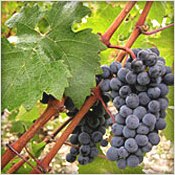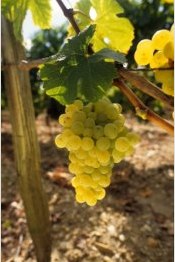Yesterday gave you a summary of Bordeaux wine. If you know that much, its a great start! Today I’ve provided a little more detail the Grape Varieties and Regions of Bordeaux, but still tried to keep it simple.
* Bordeaux Grape Varieties
- Red
 Cabernet Sauvignon: The King of Bordeaux with rich tannins (what gives wine its structure and astringency) creates deep, complex and harmonious bouquet wines. It’s less intensely colored than Merlot. Aromas and taste of spice, cedar and black fruit.
Cabernet Sauvignon: The King of Bordeaux with rich tannins (what gives wine its structure and astringency) creates deep, complex and harmonious bouquet wines. It’s less intensely colored than Merlot. Aromas and taste of spice, cedar and black fruit.- Merlot: This grape creates a velvety red color in wine. It softens Cabernet Sauvignon’s richness and provides a red berry taste and aroma.
- Cabernet Franc: Produces a powerful wine with subtle aromas. It adds roundness to Cabernet Sauvignon and fruity notes of raspberry.
- Additional red grapes used although less widely grown are Malbec (good for Rosés), Petit Verdot (robust and spicy, similar to Syrah, found in grand Châteaux wines) and Carmenère (red fruits, spice, berries).
- White
Sauvignon Blanc: The primary white grape of Bordeaux is flavorful, round and lively with an aromatic balance of citrus fruits and white flowers.
- Sémillon: Blended with Sauvignon Blanc, it produces deep golden sweet white wines.
- Muscadelle: Its roundness, musky orange and powerful floral aromas produce dry whites and sweet white wines.
- Additional white grapes used although less widely grown Colombard, Merlot blanc, Ugni blanc.
*Â Regions of Bordeaux
I was overwhelmed by the sheer number of wineries and AOCs (Appellation of Controlled Origin, the official wine regions of France)… 25% of France’s AOCs are in Bordeaux. There are 60 total AOCs like Médoc, Graves, Pessac-Léognan, Sauternes and Barsac, Saint-Emilion, and Pomerol.
The Gironde River flows through Bordeaux creating a Left Bank and Right Bank.
- Left Bank‘s 10 AOCs are in Médoc (north of the city of Bordeaux) and Graves (south of the city). Cabernet Sauvignon rules the Left Bank… a fuller bodied red wine with more tannins.
- Right Bank AOCs are dominated by Merlot giving a more accessible, medium bodied, softer tannins wine that’s easier to drink when young.
Each AOC has a distinctive terrior… a combination of the soil (some clay, some gravel) and microclimate (close to the Ocean, close to the river, on a slope getting lots of sun). Each terrior in Bordeaux produces a distinctive grape and wine. As French wines are labeled for their region not their grape, it helps to know a little about the regions/AOCs.
The Bordeaux Wine Council divides the 60 AOC into 6 AOC families grouped by similar wine styles.
- Bordeaux & Bordeaux Supérieur: Produced anywhere in Bordeaux. They represent over 50% of Bordeaux’s production and embody the Bordeaux style of ‘harmonious elegance and aromatic complexity.’
- Côtes de Bordeaux: On the Right Bank with excellent exposure to sun, it produces wines that are aromatic and pleasant to drink with notes of ripe fruit and velvety tannins. Merlot dominates. More familiar AOCs in this area are Blaye and Côtes de Bourg. 14% of Bordeaux wines.
- Médoc & Graves: Stretching 100 miles on the Left Bank and dominated by Cabernet Sauvignon, the area produces remarkable powerful and complex red wine. Many of Bordeaux’s classified* wines are produced here. In addition to the Médoc and Graves AOC names, you may recognize Margaux, Pauillac (home to the world renowned Châteaux Lafite, Latour and Mouton Rothschild, 3 out of the 5 famous 1855 classification*), Pessac-Léognan, Saint-Estèphe and Saint-Julien. 15% of Bordeaux’s wine production.
- Saint-Emilion, Pomerol and Fronsac: AOCs on the Right Bank close to the city of Libourne. Merlot is the primary grape used to produce aromatic, supple, elegant and velvety wine. Pomerol is often considered the best of Bordeaux. Saint-Emilion (“the hills with a thousand chateaux”) is a beautiful medieval village and UNESCO World Heritage Site. 10% of Bordeaux wine production.
- Dry White Wines: 12 AOCs across Bordeaux produce fresh and aromatic whites primarily with Sauvignon Blanc. Primary AOCs are Bordeaux, Graves, Entre Deux Mers, Pessac-Léognan. 8% of Bordeaux wine production.
- Sweet White Wines: They come from 12 AOC’s mainly in the south of Bordeaux like Barsac, Cadillac and Sauternes. The over ripening of the grapes produces golden wines extremely elegant, aromatic and smooth. 3% of Bordeaux wine production.
This interactive map on the Bordeaux Wine Council’s U.S. site is very helpful to visualize the AOC families and read more. It even gives you the pronunciation of each AOC!
*A few notes on Classified wines or Crus. There are 6 major categories of quality classification that have developed over the years. Not all wines are included for various reasons (wineries weren’t around when they were developed, etc.). The most famous is The 1855 Classification of the Medoc and Graves chateaux. When you see “Cru Classeé” it means “Classified Growth”, so it falls into one of the 6 classification systems. There are First Growths (Premiers Crus…the top) through Fifth Growths (Cinquièmes Crus). If a wine isn’t ‘classified’ or ‘cru,’ it doesn’t mean it’s a bad wine. You just know a “Cru’ is a good one.
Tomorrow we’ll take a look at putting this together to buy a bottle.


